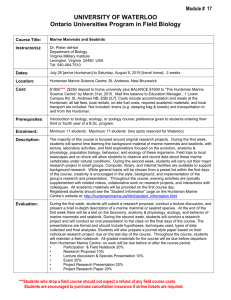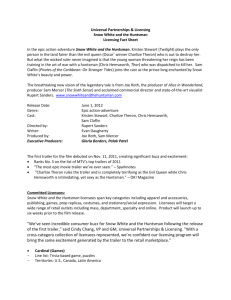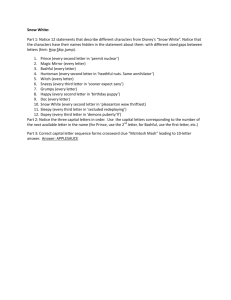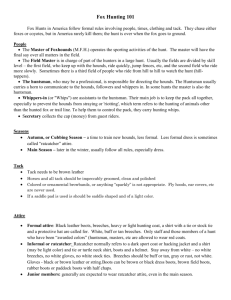Teachers' institutes provide hands-on science
advertisement
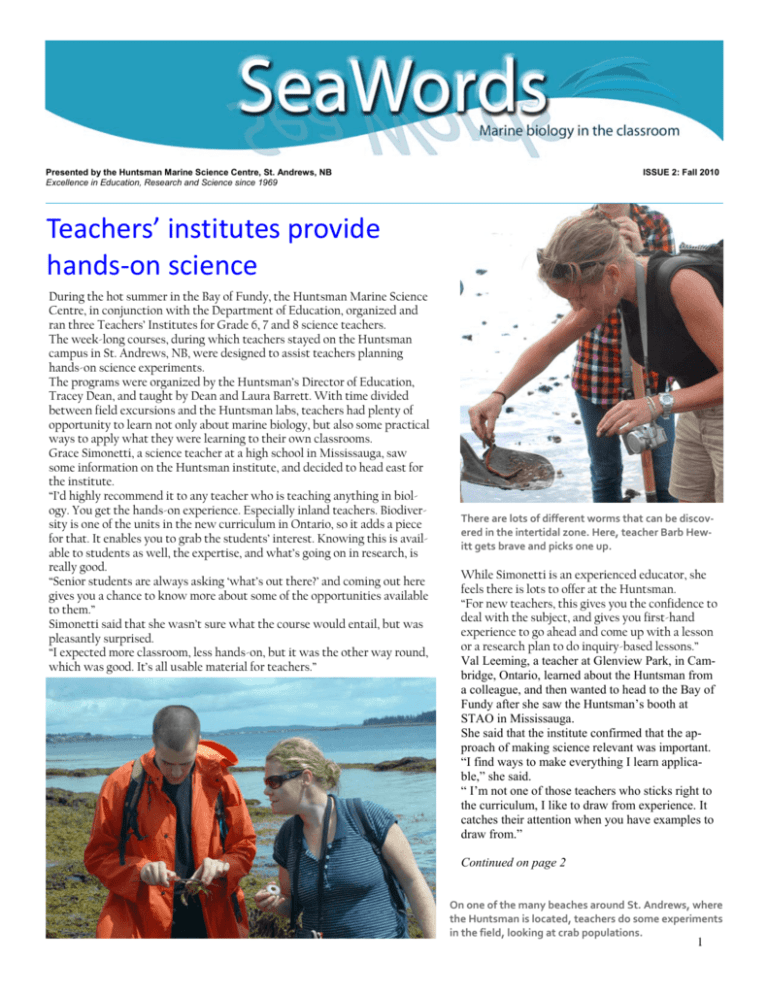
Presented by the Huntsman Marine Science Centre, St. Andrews, NB Excellence in Education, Research and Science since 1969 ISSUE 2: Fall 2010 Teachers’ institutes provide hands‐on science During the hot summer in the Bay of Fundy, the Huntsman Marine Science Centre, in conjunction with the Department of Education, organized and ran three Teachers’ Institutes for Grade 6, 7 and 8 science teachers. The week-long courses, during which teachers stayed on the Huntsman campus in St. Andrews, NB, were designed to assist teachers planning hands-on science experiments. The programs were organized by the Huntsman’s Director of Education, Tracey Dean, and taught by Dean and Laura Barrett. With time divided between field excursions and the Huntsman labs, teachers had plenty of opportunity to learn not only about marine biology, but also some practical ways to apply what they were learning to their own classrooms. Grace Simonetti, a science teacher at a high school in Mississauga, saw some information on the Huntsman institute, and decided to head east for the institute. “I’d highly recommend it to any teacher who is teaching anything in biology. You get the hands-on experience. Especially inland teachers. Biodiversity is one of the units in the new curriculum in Ontario, so it adds a piece for that. It enables you to grab the students’ interest. Knowing this is available to students as well, the expertise, and what’s going on in research, is really good. “Senior students are always asking ‘what’s out there?’ and coming out here gives you a chance to know more about some of the opportunities available to them.” Simonetti said that she wasn’t sure what the course would entail, but was pleasantly surprised. “I expected more classroom, less hands-on, but it was the other way round, which was good. It’s all usable material for teachers.” Investigating the life on the bottom of the Bay of Fundy on the Huntsman’s research vessel, the Fundy Spray. There are lots of different worms that can be discov‐ ered in the intertidal zone. Here, teacher Barb Hew‐ itt gets brave and picks one up. While Simonetti is an experienced educator, she feels there is lots to offer at the Huntsman. “For new teachers, this gives you the confidence to deal with the subject, and gives you first-hand experience to go ahead and come up with a lesson or a research plan to do inquiry-based lessons.” Val Leeming, a teacher at Glenview Park, in Cambridge, Ontario, learned about the Huntsman from a colleague, and then wanted to head to the Bay of Fundy after she saw the Huntsman’s booth at STAO in Mississauga. She said that the institute confirmed that the approach of making science relevant was important. “I find ways to make everything I learn applicable,” she said. “ I’m not one of those teachers who sticks right to the curriculum, I like to draw from experience. It catches their attention when you have examples to draw from.” Continued on page 2 On one of the many beaches around St. Andrews, where the Huntsman is located, teachers do some experiments in the field, looking at crab populations. 1 Teachers Institutes Continued from page 1 “It’s nice to meet scientists and learn that science isn’t static and that there’s so much going on. The students see it in the textbooks and that’s the way it’s got to be, but I tell them science is always changing,” Leeming said. Velma Martins, from Toronto, said that walking and exploring the beaches, and seeing live creatures was a highlight. And as well as applying what she’d learned to the classroom, she believed that the students would also benefit from a trip to the Huntsman. “I would love to be able to bring 20 biology students here and spend a week here with them. We have a diversity unit, and this would be perfect,” she said, adding that she would definitely look into arranging a trip east. The Huntsman runs of institutes of varying lengths for different grade levels. For more information on the courses for teachers, or for students, visit the Huntsman online at www.huntsmanmarine.ca or email tdean@huntsmanmarine.ca Fun at the Huntsman Left: Students have an opportunity to see creatures in their natural habitat, as well as in the laboratories. In addition, the Huntsman has an aquarium, with marine mammals and a popular touch pool, for more opportuni‐ ties to handle and learn more about marine creatures. As well as the labs, students get to go out to the beaches and study on the intertidal zone, as well as finding the species that live there. Above: Students that head out into the Bay of Fundy get to see first‐hand what’s on the bottom of the ocean. Right: Students from Deer Island school tackle some behaviour experi‐ ments in the lab during the Grade 6 Ocean Discovery program. The 2010‐ 11 program, which is a partnership between the Huntsman and School District 10, has already started. From the Huntsman’s research vessel, the Fundy Spray, students get to do plankton tows, take readings and sometimes head out to see some of the marine mammals that live out in the Bay. Schools visiting the Huntsman It has been a busy year for the Education Department, as schools from across the continent stayed, studied, learned and enjoyed the Bay of Fundy, the Huntsman’s labs, accommodation and food. In 2010 (not counting universities and teachers’ workshops), we’ve welcomed the following schools: Miss Edgar’s & Miss Cramp’s School, Montreal, QC Vincent Massey Elementary, St. Andrews, NB Quispamsis Middle School, NB White Head Elementary School, NB South Carleton High, Ottawa, ON West Carleton High, Ottawa, ON All Saints, Kanata, QC St. George Elementary, NB Beaconsfield High, Beaconsfield, QC Harbour View, Saint John, NB St. Joseph High, Nepean, ON St. Mark High School, Manotick, ON Rohan Woods, St. Louis, MO Ashbury College, Ottawa, ON Immaculata School, Ottawa, ON Blacks Harbour School, NB Turner Fenton School, Brampton, ON Glenburnie School, Oakville, ON Glenview High, Toronto, ON Sedbergh School, Montebello, QC Mother Teresa School, Ottawa, ON Saint John High, Saint John, NB Northeast Kings, Canning, NS St. Francis Xavier, Gloucester, ON Essex Agricultural, Danvers, MA Back Bay Elementary, Back Bay, NB Riverview High, Riverview, NB Laval Liberty, Laval, QC Sacred Heart High, Stittsville, ON Royal West Academy, Montreal, QC Crestwood College, Peterborough, ON Lindsay Place, Pointe Claire, QC MacDonald High, Ste. Anne‐de‐Bellevue, QC Deer Island School, NB Campobello School, NB Grand Manan, NB St. Stephen Middle School, NB Le Collège Français, Toronto, ON 2 Feature Teacher Teacher Name: Andre Potvin Present School: Principal, Lester B. Pearson Catholic High School, 2072 Jasmine Cr. Gloucester, ON K1J 8M5; 613-741-4525; Fax – 613-741-9593 How did you find out about the Huntsman field courses? I first learned about the Huntsman and the possibility of having my students participate in a marine biology field trip through a flyer provided by a Toronto travel company. How many years have you been bringing students? 20 years How many students have you brought over the years? Likely in the range of about 1,100. We generally bring about 55-60 students a year. Describe the evolution of your trips. The trip started in 1990 when I was at St. Matthew. I took about 20 students on this first trip. I then expanded the trip to include several schools to ensure sufficient student numbers each year. The trip then expanded to include an overnight stay on Grand Manan. It grew more popular and we added a second week to include additional schools. This year, we had six schools involved, spread over two weeks in September. It was likely our third year in running the trip that I took over the organization from the travel agent. We also evolved from taking the overnight train from Ottawa to McAdam, N.B., to the bus, when the VIA route was cancelled about 10 or 12 years ago. The Ontario Science curriculum has changed over the years, resulting in some changes on how we approach the trip program. We have always included the excursion as part of the assessment and evaluation for the Grade 12 university level biology course. What is the hardest part of organizing the trip? Cost is always the prohibitive factor. I currently charge $960 per student, which covers all expenses. Fundraising is a key issue to help reduce the cost. Otherwise, the trip flows like clockwork. Tracey Dean, Education Director at the Huntsman, has worked with us over the 20 years. She has provided the flexibility in programming to meet the specific needs of each school and teacher. This flexibility and consistency of educational expertise from Tracey has been a key factor in the success of this excursion. What are some of the highlights? The key highlight is the whale watch. We have had some amazing watches with right whales virtually swimming all around and under our boat. Of the 20 years, we have only not seen whales once, and that was because we were not able to get out due to rough weather. The other key highlight is the hands-on experiences throughout this excursion. Working with live marine organisms in their natural habitat and in the lab is a dream come true for both students and staff. Do you know of any of your students who have gone on to study science at a higher level? Oh yes, many. And some in marine biology as well. I have spoken to parents of students who attended many years ago and they say that their child still talks about this experience as being their best high school educational opportunity they had. Know someone who should be a feature teacher in SeaWords? Email Tracey Dean at tdean@huntsmanmarine.ca to suggest someone we should include! What is it? Guess what this marine creature is and win a Huntsman travel mug! Email your answer (or best guess!) to: huntsman@huntsmanmarine.ca by December 15, and you have the chance to win a free Huntsman travel mug. First answer drawn from all the correct entries received will win the prize—please include your mailing address in case you’re the winner! 3 Activity: Apple Ocean Based on the Apple Ocean activity written by Lindy Millman from Current Vol. 8 No. 3, 1988 Grade level: Grade 4 and up. Purpose: To learn about the limited productive areas in the ocean. Background: Though the ocean appears uniform to us, not all regions are the same. The most productive areas tend to be along coastlines above the continental shelf. The continental shelf is the part of the submerged coast which gradually slopes seaward, with depths to 200 m. This area is productive because in shallow, well-mixed shelf waters nutrients recycle from the bottom and nutrients run off from land. The greatest productivity in the ocean lies within the top 100 metres, the depth to which light can penetrate. This area, the photic zone, is where photosynthesis can take place. Yet even within this zone, light drops off dramatically; at 100 meters the amount of light is only 1% of what it is at the surface. Since most marine life depends in some way on photosynthesizing plants, especially phytoplankton, most ocean life is concentrated in this narrow photic zone. Materials: Apples, plastic knives. Procedure: Cut the apple into four equal pieces. Set one of the pieces aside; this represents the land. Take one of the three “Ocean” pieces and cut it in half. This piece, 1/8 of the world’s surface, represents the productive zones of the oceans. Cut this 1/8 piece into four equal parts. One of these represents the productive area along the Atlantic coast of North America (Newfoundland’s Grand Banks, the Nova Scotia shelf, Georges Bank off Cape Cod, etc). Eat the remaining 2 parts of your apple. These represent the open ocean or “desert” of the ocean. Questions: What does this tell you about the amount of productive aquatic area in the world? Discuss the importance of productive coastal ecosystems, in terms of biodiversity and as a food source. Investigate the threats to coastal ecosystems, such as development, overfishing, and pollutants. How can we preserve coastal ecosystems? About the Huntsman... The Huntsman Marine Science Centre is a not-for-profit facility in St. Andrews, N.B., dedicated to education, research and applied science. Thousands of students come to our campus each year, from elementary school to university level. We publish this newsletter specifically for teachers three times a year. If you have any marine biology questions, ideas for features, or things you’d like to see us cover, please write to us at: huntsman@huntsmanmarine.ca or visit www.huntsmanmarine.ca SeaWords is published twice a year by the Huntsman Marine Science Centre. For more information, or to contribute information, contact: Huntsman Marine Science Centre 1 Lower Campus Road St. Andrews by‐the‐Sea, NB E5B 2L7 Canada 506.529‐1200 huntsman@huntsmanmarine.ca Visit us online at www.huntsmanmarine.ca Facts: Moon Snail Moon snails are fascinating molluscs that occur in the Bay of Fundy. They are a favourite with students attending Huntsman field courses, as well as the aquarium, because they produce lots of slime! Did you know? Moon snails have an enormous foot that can almost cover their shell, but it can be completely retracted by releasing water. Moon snails plow through the sand, half‐ buried, searching for prey such as clams. When prey is found, the moon snail wraps its large foot around it, drills a circular beveled hole in the shell, and sucks the animal out. The moon snail drills the hole by secreting acids, which soften the shell and then scraping the shell with its radula, a tongue covered in tiny teeth. An adult moon snail can eat a clam every 4 days! Moon snails lay their eggs in a mass of mucus and sand, called a “sand collar.” These are commonly seen on local beaches (right). For an interesting activity, you can pick a different marine spe‐ cies for each member of your class, and have them research the creature and come up with what they think are the three most interesting facts, and have the rest of the class vote on the ten facts they think are the most interesting. We’d love to see the results! For information on some of the amazing animals that live in the Bay of Fundy visit www.huntsmanmarine.ca/html/ 4
